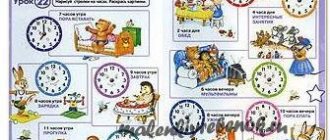Notes and presentation for the class hour “Rights and Responsibilities of the Child”; 2nd grade
Primary school teacher
MBOU "Lyceum No. 81" of Novosibirsk
Bochkar Marina Sergeevna
Goal: to introduce children to the “Constitution” of Russia, the “Convention on the Rights of the Child”, and the universal “Declaration of Human Rights”.
Objectives: to help children understand the concepts of “rights” and “responsibilities”;
generalize children's knowledge about the basic rights of the child; contribute to the development of children's motivation to use legal knowledge in life.
to form a respectful attitude towards each other, to instill in students a sense of civic responsibility
Equipment: Dictionary S.I. Ozhegova, puzzles, cards with key words, exhibition of drawings, presentation.
Progress of the lesson
1. Organizational moment.
2. Announcing the topic and setting the goal of the lesson:
Today we will try to figure out where in everyday life we exercise our rights, duties and bear responsibility.
A long time ago, thousands of years ago, people appeared on Earth. At the same time, the main questions appeared:
What can people do and what can't they do?
What are they obligated to do and what are they not obligated to do?
What are they entitled to and what are they not entitled to?
And so on.
Without a clear answer to these questions, life turned into a complete nightmare and confusion.
In the end, people managed to solve the Essential Questions, and the Universal Declaration of Human Rights was born. Over time, people realized that the child needed special protection and care.
Declaration of the Rights of the Child.
In 1959, the UN General Assembly proclaimed the Declaration of the Rights of the Child.
It argues that some human rights are directly relevant to children, who need special care and attention. Its content was a call for goodness and justice for children. However, declarations are only advisory in nature; their norms are not binding.
Another thing is the convention
; it is a treaty that must be strictly implemented by those who sign it. On November 20, 1989, the Convention on the Rights of the Child was unanimously adopted by the UN General Assembly. It is designed to create favorable conditions for the development of children.
In our state, as in any other, there is a basic law
by which we live.
- What is the name of this law?
The laws that regulate relations between the state and society are written in the Constitution
- the fundamental law of the state. (Demonstration of the book.)
3.Work in groups
— Remember what rights are guaranteed to you by the state?
4. Discussion of illustrations for fairy tales (ON SLIDES)
Many literary works, one way or another, touch upon Human rights. Let's remember these works...
5. Responsibilities. Analysis of situations. Situations play out.
Ira: Nastya, you are on duty today, please stay and wash the board and water the flowers.
Nastya: Ira, you have no right! The Convention prohibits child labor.
Who is right?
Vanya: Dima, you’re not ready for reading on Monday!
Dima: Yesterday was Sunday. I have every right to rest.
Who is right?
Conclusion. While protecting your rights, you must not forget about your responsibilities.
6. REFLECTION
- We talked about the rights, duties and responsibilities of children. I offer you situations from your life. If you answer the questions honestly, you will understand whether you are doing everything right, or whether you still need to work on yourself.
Situation 1 – You have been assigned to design a New Year’s newspaper:
a) I’ll put everything aside and get on with the paperwork b) I’ll do it when I have free time c) I’ll delegate it to another classmate
Situation 2 – You are sitting in transport. An elderly woman comes in:
a) I’ll give up my seat b) I’ll ask my neighbor to give up my seat c) I’ll turn away and look out the window
Situation 3 – You see your classmate being beaten:
a) I’ll try to protect b) I’ll ask passers-by to intervene c) I’ll pass by
Situation 4 – You found a wallet containing 100 rubles:
a) I’ll try to return it to the owner b) I’ll give it to an adult c) I’ll take it for myself
Answer a) – 5 points; b) – 3 points; c) – 0 points.
If you score between 15 and 20 points, you’re doing great! Continue to act with the same confidence. Your parents and school can be proud of you.
If from 10 to 15 points, you have something to work on.
If less than 10 points, there is nothing left to do but pull yourself together and work hard on yourself.
7. Summary
Both adults and children have rights.
But we should not forget that in addition to rights, everyone also has responsibilities to society.
When defending your rights, do not forget that other people also have the same rights as yours.
Respect other people's rights!
The development of the concept of human rights led to the fact that the rights of the child were allocated to a special category. By the beginning of the 21st century, a system for protecting children’s rights at the international level, supported by relevant legal documents, had developed in the world. The fundamental international documents on the protection of children's rights are the Universal Declaration of Human Rights and the Convention on the Rights of the Child. Practical support of the principles enshrined in these documents is the main task of the state in Russia.
We bring to your attention materials for conducting a class hour “Children’s Rights” for students in grades 6-7.
Author: T. V. Ryabtseva
Recommendations for working with the presentation of the class hour “The Rights of the Child” for students in grades 6–7
Lesson option [PDF] [DOCX]
Presentation [PDF] [PPTX]
Student Materials (worksheet) [PDF] [DOCX]
Teacher's materials [PDF] [DOCX]
Quiz [PDF] [DOCX]
Goal: formation of legal consciousness of students, their legal culture.
Tasks:
- develop a general understanding of the rights of the child as enshrined in the Declaration of the Rights of the Child and the Convention on the Rights of the Child;
- promote the development of students’ interest in issues of legal education, their determination of their attitude to law as a public value;
- help schoolchildren formulate their own ideas about modern legal and moral values of society;
- contribute to the development of students’ competencies in protecting the rights, freedoms and legitimate interests of the individual.
The methodological material is advisory in nature; The class teacher, taking into account the characteristics of each class, can vary the tasks, their number, and change the stages of the class hour.
Exercise.
Watch the video. What do you think the phrase “Children have the right to rights” means?
Formulate the topic and main questions of the lesson.
Today we will talk about the rights of the child.
Why do you think this topic is important and relevant?
Every person should know their rights. Minor children are no exception to this rule. From birth, a child is a full-fledged citizen of his country, is endowed with rights, and with age acquires responsibilities.
Every year on November 20, World Children's Rights Day is celebrated.
On November 20, 1959, the UN General Assembly adopted the Declaration of the Rights of the Child , containing 10 essential principles for ensuring the protection and welfare of children.
On November 20, 1989, the UN General Assembly adopted the Convention on the Rights of the Child , an important document regulating the protection of children's rights throughout the world. The Convention is not a list of children’s rights, but a list of the obligations that states have assumed to protect these rights.
Questions:
1. Why do you think there was a need to separate children's rights into a separate category?
2. Why, 30 years after the adoption of the Declaration, was it necessary to adopt another document on the rights of the child - the Convention?
(The Declaration is not binding, it is a recommendation that proclaims the basic principles and program provisions. A convention is an agreement on a special issue that is binding on those states that have joined it. By signing the convention, states declare their obligation to comply with these provisions and in case of non-compliance they are responsible to the international community).
The UN General Assembly (United Nations) recommended that all countries introduce the practice of celebrating World Children's Rights Day as a day of world brotherhood and mutual understanding among children. She invited governments to celebrate this day on any day that each of them considers appropriate.
Task No. 1. (example: all tasks in the appendix)
Read the text and answer the questions.
Questions:
- How is World Children's Day celebrated in different countries?
- What do different nations have in common in the traditions of celebrating this day? Explain your answer.
Task No. 2.
There is a symbol of International Children's Day - a flag recognized today in more than thirty countries around the world.
Consider the image of the flag. Guess what the elements of the flag symbolize.
For reference.
Task No. 3.
Read Article 1 of the Convention on the Rights of the Child. How can one explain this length of childhood?
Read Article 6 of the Convention on the Rights of the Child.
Based on the wording of the article, continue the phrase: “The Convention is not a list of children’s rights, but a list of those obligations ...”
(For example, ... which states have assumed to protect these rights.)
Task No. 4.
Get acquainted with some articles of the Convention on the Rights of the Child. Can you guess what measures are being taken in the states that have acceded to the Convention to guarantee the observance of these rights?
- Inalienable right to life (Article 6).
- The right to a name, citizenship, preservation of one’s individuality (Articles 7, 8).
- The right to freely express one’s opinion (Article 13).
- Access to information (Article 17).
- Children with disabilities have the right to special care (Article 23).
- Right to health care (Article 24).
- The child’s right to education (Article 28).
- The right to rest and leisure (Article 31).
- The right to protection from economic exploitation (Article 32).
Additional material: full text of the Convention on the Rights of the Child.
In what cases can some children's rights be limited? Give examples.
(For example, the right to freedom to seek, receive and impart information may be subject to restrictions in order to respect the rights or reputations of others or to protect national security or public order, or public health or morals.)
Under no circumstances can the right to life be limited!
Task No. 5.
Familiarize yourself with the proposed situations and the content of the articles of the Convention on the Rights of the Child. Match the child's right with the proposed situation. Explain your choice.
The Russian Federation acceded to the Convention on the Rights of the Child in 1990. Children's rights are reflected in the Constitution of the Russian Federation and the Family Code of the Russian Federation; In 1998, the Federal Law “On Basic Guarantees of the Rights of the Child in the Russian Federation (No. 124-FZ) and other legal acts was adopted. One of these laws is Federal Law No. 273-FZ of December 29, 2012 “On Education in the Russian Federation.”
Task No. 6.
Read excerpts from articles of the Law “On Education in the Russian Federation”. What two groups can these articles be divided into? Explain your answer. Draw a conclusion.
Game-exercise “Legal pictograms”
Work in groups.
A pictogram (picture letter) is a symbol that conveys information about an object or idea through illustration.
Task No. 7.
After studying the articles of the Convention on the Rights of the Child, select two that attracted your special attention and “encode” them in the drawing. Ask another group to determine the content of the article you have chosen.
Task No. 8.
Express in one sentence the essence of the Convention on the Rights of the Child.
(For example: as much respect as possible for the child, his rights, care for him, love for him.)





